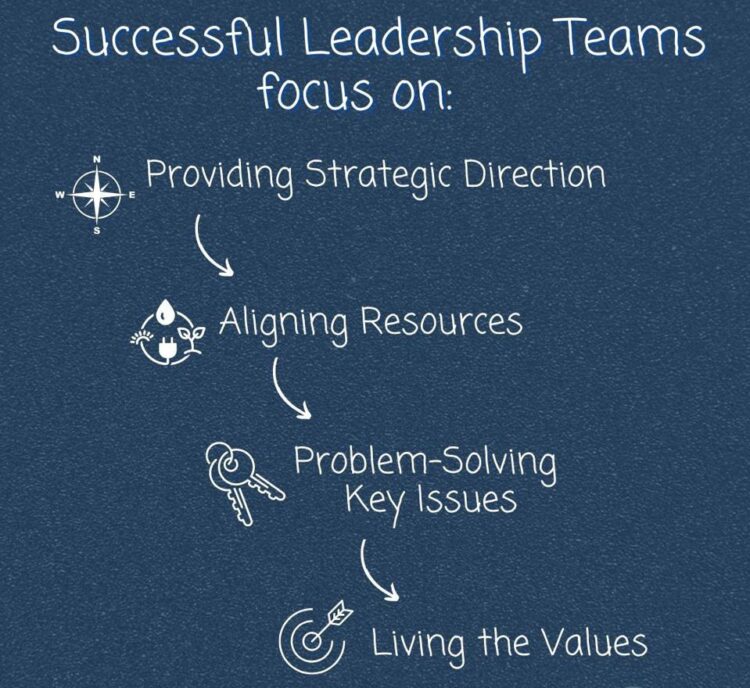Leadership teams have a unique role because, in addition to each team member having responsibility for their respective team’s success, they have a more strategic set of shared responsibilities to ensure the organization’s success. An effective leadership team is critical because they are the only ones with the authority to make decisions and allocate resources to enable the organization to collectively grow, adapt, and evolve to better serve its vision and mission.
Too often, leadership teams spend most of their time together sharing general updates, addressing day-to-day issues, and creating space for employees and projects to get leadership exposure. These activities are valuable and necessary, just not at the expense of accomplishing their most strategic tasks. The best leadership teams continually prioritize their time and energy to ensure they deliver on these 4 Key Responsibilities Of Great Leadership Teams.
1) Providing Strategic Direction
A common purpose, values, goals, and priorities give the organization its identity and direction. These commonalities unite the organization’s daily efforts to advance its shared goals. The leadership team has responsibility for providing clarity of “who we are, “what we do,” and “how we do it.” This foundational clarity enables an environment where employees can collectively focus on pursuing the organization’s most important goals. Research shows that highly effective organizations share a common vision, are clear on their purpose, live their values, and link strategy and actions to serving this vision and mission.
𝟮) Aligning Resources
The leadership team is responsible for ensuring everyone has a clear picture of who is accountable for what, the extent of each group’s authority, and how people must work together to accomplish common goals. If done correctly, all employees can see a direct alignment with the vision and mission, organizational values, and strategic goals and plans. Aligned resources and clear expectations help instill focus and accountability, so everyone executes on the vision daily. Leadership teams must ensure that their organization’s ongoing efforts and resources align with your overall strategy, or they will not achieve their long-term goals.
Great leadership teams continually focus on the following alignment practices.
- Clearly communicate vision and strategic goals – Leaders need to communicate a clear, unified leadership vision.
- Clarify roles – Employees should understand how their specific position and responsibilities contribute to the organization’s goals.
- Measure and communicate progress – Employees need clear objectives to know if the organization is achieving its strategic goals. A simple and visible scorecard should communicate to all employees how they are progressing toward strategic goals.
- Upward feedback loops – Typically, leaders are not engaged in the daily tasks required for achieving strategic goals, making it necessary to establish safe feedback loops to help them understand the reality of what is happening. This upward feedback enables the leadership team to adjust appropriately for ongoing success.
- Celebrate: Leadership teams need to deliberate about recognizing and acknowledging accomplishments and progress toward their most strategic goals.
3) Problem-Solving Key Issues
The best leadership teams are great at problem-solving. Resolving critical issues that get in the way of accomplishing strategic goals should be the central component of a leadership team’s recurring meeting focus. Below are best practices for teams that excel with inclusive problem-solving to ensure strategic goals stay on track.
- Dedicated time to assess the progress of strategic goals and problem-solving issues when they are off-track.
- Defined approach and inclusive process for collectively engaging in problem-solving.
- Simple and straightforward scorecard to track progress and gaps.
- Clear agreements for the next steps and accountability are documented and revisited during subsequent meetings.
Resolving critical issues that get in the way of accomplishing the organization’s most strategic goals must be a central component of the leadership team’s purpose and focus.
4) Living the Values
One of the biggest mistakes leadership teams can make is thinking that shared values are nice to have rather than an all-important necessity. The truth is that shared values are vital to helping employees find purpose at work and improving employee well-being, motivation, retention, and performance. Organizations that connect with employees and build community through a defined set of shared values create a culture where employees feel valued, heard, and capable of doing their best work.
The leadership team is responsible for ensuring the organization is diligent in selecting, promoting, rewarding, and holding accountable their leaders to live the values in their day-to-day actions and decision-making. There is nothing more disparaging for employees than having a leader that demonstrates behaviors that do not align with their values, and no one seems to care.
Conclusion
The best leadership teams understand that their highest calling is to build a culture that enables employees to feel heard, valued, and capable of doing their best work in pursuit of the organization’s vision and mission. Successfully fulfilling these 4 Key Responsibilities allow leadership teams to evolve, scale, and grow their organizations during good and challenging times.







